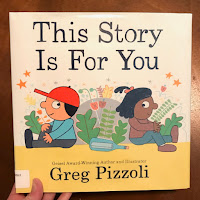 |
| Book cover for Square |
Square is the second book in Mac Barnett and Jon Klassen’s Shapes series. I wouldn’t call it a sequel, as it really has nothing to do with Triangle which came before it (see the Guessing Geisel post on Triangle), except that Square, our main character, appears in both books.
This is a picture book well-suited for beginning readers. The sentences are short and to the point, and the the vocabulary isn’t too difficult. There are a few words like “sculpture” and “genius” that might be new for some readers, but these words are added slowly enough to make reading Square a positive learning experience. The few difficult words are also repeated several times throughout the book, which helps with retention. The plot is pretty simple and as far I could tell, the kids I read it to and the kids I’ve had read it independently had no trouble following it.
The illustrations are classic Jon Klassen. The character’s expressions and a lot of the humor are conveyed through the placement of the pupils in the character’s eyes, so the illustrations share the story-telling duties with the text.
 |
| Three images from the book all of Square, first in a puddle, then on a rock, finally in the rain. |
I feel like kids can really relate to Square as a character. What child hasn’t been asked to do something they’ve never done before, something they have no idea how to do? The paralyzing anxiety that comes with that is real. There’s a really positive message in Square. If we give a new task a shot and work hard, who knows what will happen? It’s better than not trying. Mac Barnett relays this message to us in such a funny, subtle way, it doesn’t feel didactic or preachy at all.
I’ve read Square to several groups of children, and the reception has been great. The kids thought it was funny, and they loved the narrator addressing them directly at the end and asking for their opinion. That has led to some really good discussion about what genius really is and accidental art.
I think this book should definitely be on the Geisel committee’s radar. It’s distinguished in every aspect and the fact that it’s part of a series shouldn’t harm it in any way. Square is new and fresh and stands completely on its own.


































